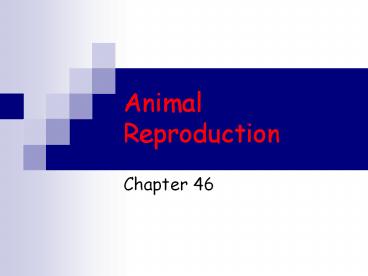Animal Reproduction PowerPoint PPT Presentation
1 / 39
Title: Animal Reproduction
1
Animal Reproduction
- Chapter 46
2
Reproduction in the Animal Kingdom
- Sexual
- Asexual
- Fission
- Budding
- Fragmentation Regeneration
- Parthenogenesis? egg develops without being
fertilized
3
Parthenogenesis
- Development of an unfertilized egg
- honey bees
- drones males produced through parthenogenesis ?
haploid - workers queens females produced from
fertilized eggs ? diploid
queen
worker
drone
4
Reproductive Cycles and Patterns
- Most animals exhibit cycles in reproductive
activity - Often related to changing seasons
- Reproductive cycles
- Are controlled by hormones and environmental cues
5
Fertilization
- Plays an important part in sexual reproduction
- Joining of egg sperm
- external
- usually aquatic animals
- internal
- usually land animals
6
Patterns of Sexual Reproduction
- External fertilization, external development
- Internal Fertilization, External Development
- Internal Fertilization, Internal Development
7
Hermaphrodites
- Certain Organisms seldom encounter a mate
- Solution ? hermaphroditism
- In which each individual has both male and female
reproductive
8
Sequential Hermaphroditism
- An individual reverses its sex during its lifetime
9
Male Reproductive System
10
Male Reproductive System
- Testicles
- produces sperm hormones
- Scrotum
- sac that holds testicles outside of body
- Epididymis
- where sperm mature
- Vas deferens
- tubes for sperm to travel from testes to penis
- Prostate, seminal vesicles, Cowpers
(bulbourethal) glands - nutrient rich fluid to feed protect sperm
- buffer to counteract acids in vagina
11
Male reproductive system
- Sperm production
- over 100 million produced per day!
- 2.5 million released per drop!
- Testes epididymis
- sperm production maturation
- Glands
- seminal vesicles, prostate, bulbourethal
- produce seminal fluid nutrient-rich
12
Spermatogenesis
Testis
Epididymis
Germ cell (diploid)
Coiled seminiferous tubules
1 spermatocyte (diploid)
MEIOSIS I
2 spermatocytes (haploid)
MEIOSIS II
Vas deferens
Spermatids (haploid)
Spermatozoa
Cross-section of seminiferous tubule
13
Female Reproductive System
14
Female Reproductive System
- Ovaries
- produces eggs hormones
- Uterus
- nurtures fetus lining builds up each month
- Fallopian tubes
- tubes for eggs to travel from ovaries to uterus
- Cervix
- opening to uterus, dilates 10cm (4 inches) for
birthing baby - Vagina
- birth canal for birthing baby
15
Female Reproductive System
16
Oogenesis
- What is the advantage of this development system?
Meiosis 1 completed during egg maturation
ovulation
Meiosis 2 completed triggered by fertilization
17
The reproductive cycle of the human female
- The Ovarian Cycle
- The Uterine (Menstrual) Cycle
- Menopause
18
Female Hormones
- FSH LH
- release from pituitary
- stimulates egg development hormone release
- peak release release of egg (ovulation)
- Estrogen
- released from ovary cells around developing egg
- stimulates growth of lining of uterus
- lowered levels menstruation
- Progesterone
- released from corpus luteum in ovaries
- cells that used to take care of developing egg
- stimulates blood supply to lining of uterus
- lowered levels menstruation
19
(No Transcript)
20
The Ovarian Cycle
- In the ovarian cycle
- Hormones stimulate follicle growth, which results
in ovulation - Following ovulation
- The follicular tissue left behind transforms into
the corpus luteum
21
(No Transcript)
22
The Uterine (Menstrual) Cycle
- Occurs when the endometrium is shed
- Three Phases
- Mentrual Flow Phase? endometrium is shed and
mentrual bleeding occurs - Proliferative Phase? endometrium regenerates
thickens - Secretory Phase?endometrium thickens, if an
embryo has not implanted by the end of this
phase?A new menstrual flow commences
23
Menopause
- After about 450 cycles, human females undergo
menopause - The cessation of ovulation and menstruation
24
Fertilization
25
Placental Mammals
- Human Chorionic Gonadotropin
- Secreted by embryo acts like LH to maintain the
Corpus Luteum - Excreted in urine
- Parturition
- Birth in late pregnancy estrogen increases
- This stimulates oxytocin receptors
- Oxytocin from fetus and mother stimulate
contractions
26
Hormonal Control of the Male Reproductive System
- Testosterone and other androgens
- Are directly responsible for the primary and
secondary sex characteristics of the male
27
Androgen secretion and sperm production?
controlled by hypothalamic and pituitary hormones
28
Conception, Pregnancy and Birth
- Blastocyst
- Implants by burrowing endometrium grows over
- Provides nutrients first 2-4 weeks
29
Placenta? Derived from both maternal and fetal
cells? produce progesterone
- Materials exchange across membranes
30
Human fetal development
- The fetus just spends much of the 2nd 3rd
trimesters just growing - and doing various flip-turns kicks inside
amniotic fluid
Week 20
31
Human fetal development
- 24 weeks (6 months 2nd trimester)
fetus is covered with fine, downy hair called
lanugo. Its skin is protected by a waxy material
called vernix
32
Human fetal development
- 30 weeks (7.5 months)
umbilical cord
33
Getting crowded in there!!
- 32 weeks (8 months)
The fetus sleeps 90-95 of the day sometimes
experiences REM sleep, an indication of dreaming
34
Birth
Hormone induction
positive feedback
35
Birth (36 weeks)
Intestine
Placenta
Umbilical cord
Wall of uterus
Bladder
Cervix
Vagina
36
The end of the journey!
37
Mechanisms of some contraceptive methods
38
RU486
- Progesterone analog
- Blocks progesterone receptors in uterus lining
is shed - Prostaglandins also taken
39
Reproductive Technologies
- Ultrasound
- Amniocentesis
- Chorionic Villi Sampling (CVS)
- In Vitro Fertilization (IVF) or GIFT

